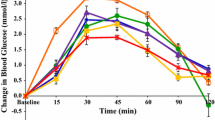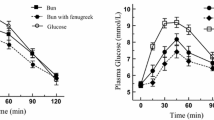Abstract
This study evaluated the glycemic response to pigeon pea (PP) – wheat flour (WF) composite biscuits by diabetic patients. Biscuits were produced from flour made from the mixture of WF and PP flour in the proportion of 100:0 (100 - PP), 75:25 (75-PP), 50:50 (50-PP), 25:75 (25-PP), and 0:100 (WF), 4.5% ginger was used as flavor. Sensory evaluation revealed that 100-PP (6.54 ± 0.05) had highest acceptability and palatability attributes (p < 0.05). Glycemic index (GI) and glycemic load (GL) of the biscuits ranged from 100 – PP (41.36 ± 0.30) to CAB (79.89 ± 1.00) and 100-PP (10.57 ± 0.01) to CAB (30.70 ± 0.40), respectively. All the composite biscuits had low GI < 60 and GL < 20. Composite biscuit may suggest a cheap, adequate and safe supplementary diet for diabetic patients.





Similar content being viewed by others
Abbreviations
- PP:
-
Pigeon pea
- WF:
-
Wheat flour
- CAB:
-
Commercially available biscuits
- BMI:
-
Body mass index
- DHG:
-
Diabetic human group
References
Oboh G, Ademiluyi AO, Akindahunsi AA (2009) Changes in polyphenol and antioxidant activity during fermentation of some underutilized legumes. Food Sci Technol 115:41–46. https://doi.org/10.1177/1082013208101022
Eneche EH (1999) Biscuit making potential of millet/pigeon pea flour blends. Plant Foods Hum Nutr 54:21–27
Ashaye OA, Olanipekun OA, Ojo SO (2015) Chemical and nutritional evaluation of biscuits processed from cassava and pigeon pea flour. J Food Process Technol 6:521. https://doi.org/10.4172/2157-7110.1000521
Suresh C, Samshar S, Durvash K (2014) Evaluation of functional properties of composite flours and sensorial attributes of composite flour biscuits. J Food Sci Technol 52(6):3681–3688. https://doi.org/10.1007/s13197-014-1427-2
Gbenga-Fabusiwa FJ, Oladele EP, Oboh G, Adefegha SA, Oshodi AA (2018) Nutritional properties, sensory qualities and glycemic response of biscuits produced from pigeon pea-wheat composite flour. J Food Biochem 42:e12505a. https://doi.org/10.1111/jfbc.12505
Kure OA, Bahago EJ, Daniel EA (1998) Studies on the proximate composition and effect of flour particle size on acceptability of biscuit produced from blends of soyabeans and plantain flours. Namida Tech-Scope J 3:17–21 https://scialert.net/fulltextmobile/?doi=pjn.2010.815.818. Accessed 14 Jan 2019
Olaoye OA, Onilude AA, Oladoye CO (2007) Bread-fruit flour in biscuit making effects on product quality. Afr J Food Sci 1:20–23 http://www.academicjournals.org/article/article1380103418. Accessed 14 Jan 2019
Jenkins DJA, Kendall CWC, Augustin LSA, Franceschi S, Hamidi M, Marchie A, Jenkins AL, Axelsen M (2000) Glycemic index: overview of implications in health and disease. Am J Clin Nutr 76(suppl):266S–273S
Jenkins DJ, Wolever TM, Taylor RH, Barker H, Fielden H, Baldwin JM, Bowling AC, Newman HC, Jenkins AL, Goff DV (1981) Glycemic index of foods: a physiological basis for carbohydrate exchange. Am J Clin Nutr 34:362–366 Google Scholar
Foster-Powell K, Miller JB (1995) International tables of glycemic index. Am J Clin Nutr 62:871S–890S Google Scholar
Brouns F, Bjorck L, Frayn KN, Gibbs AI, Lang V, Slama G, Wolver TM (2005) Glycemic index methodology. Nutr Res Rev 18:145–171. https://doi.org/10.1079/NRR2005100
Jerkins D, Kendall CWC, Augustin LSA, Franceshi S, Hamidi M, Marchie A (2002) Glycemic index: overview of implications in health and disease. Am J Clin Nutr 76:266–527. https://doi.org/10.1093/ajcn/76/1.266S
Vijan S (2010) Type 2 diabete. Ann Intern Med 152(5):ITC3–1. 13. https://doi.org/10.7326/0003-4819-152-5-201003020-01003
American Diabetes Association (ADA) (2002) Evidence–based nutrition principles and recommendations for the treatment and prevention of diabetes and related complication. Diabetes Care 25(1):202–212
Potter NN (1968) Hedonic scale; food science. Publishing Company. Inc, The Avi
Food and Agriculture Organization of the United Nations (FAO) (1998) World Health Organization (WHO) expert consultations. Carbohydrate human nutrition report of a joint FAO / WHO Expert consultation Rome 2: 11–18
Hymavathi TV, Rao SK, Boini P, Rajesh P, Rodrigues L et al (2017) Profiling of Eleusine Coracana biscuits for glycemic index, stress and lipid. MOJ Drug Des Develop Ther 1(2):00010. https://doi.org/10.15406/mojddt.2017.01.00010
Ferreti G, Bachetti T, Bender C, Oboh G, Zimmermann B (2016) Polyphenol content and glycemic load of pasta enriched with Faba bean flour. FFHD 6:291–305. https://doi.org/10.31989/ffhd.v6i5.254
Camille AK, Nestor KK, Jacko RA, Kingsley K, Asare P, Maria CC, Denis YN, Georges NA (2017) Glycemic responses, glycemic index, and glycemic load values of some street foods prepared from plantain (Musa spp., AAB genome) in Côte d’Ivoire. Foods 6:79–83. https://doi.org/10.3390/foods6090083
Gbenga-Fabusiwa FJ, Oladele EP, Oboh G, Adefegha SA, Oshodi AA (2018) Polyphenol contents and antioxidants activities of biscuits produced from ginger enriched pigeon pea -wheat composite flour blends. J Food Biochem 42:e12505. https://doi.org/10.1111/jfbc.12505
Acknowledgements
The researchers appreciate all the clinical team and the diabetic patients of out-patient medical ward of Ondo State Specialist Hospital, Akure for participating in this study.
Author information
Authors and Affiliations
Corresponding author
Ethics declarations
(see supplementary materials for additional details).
Conflict of Interest
The authors declare that they have no conflict of interest
Additional information
Publisher’s Note
Springer Nature remains neutral with regard to jurisdictional claims in published maps and institutional affiliations.
Electronic supplementary material
ESM 1
(DOC 711 kb)
Rights and permissions
About this article
Cite this article
Gbenga-Fabusiwa, F.J., Oladele, E.P., Oboh, G. et al. Glycemic Response in Diabetic Subjects to Biscuits Produced from Blends of Pigeon Pea and Wheat Flour. Plant Foods Hum Nutr 74, 553–559 (2019). https://doi.org/10.1007/s11130-019-00758-2
Published:
Issue Date:
DOI: https://doi.org/10.1007/s11130-019-00758-2




